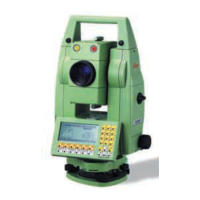
Do you have a question about the Leica TPS1100 Professional Series and is the answer not in the manual?
| Type | Total Station |
|---|---|
| Operating temperature | -20°C to +50°C |
| Laser Class | Class 1 |
| IP Rating | IP54 |
| Data storage | Internal memory |
| Communication | RS-232 |
| Angle accuracy | 1" (0.3 mgon) |
Details about instrument features like R versions, ATR, EGL, RCS, and software capabilities.
Information on the user manual, field manuals, and application program documentation.
Diagram and list identifying key components of the TPS1100 instrument.
Explanation of the EDM module, infrared and red laser beams for distance measurement.
Details on ATR/LOCK modes for motorized instruments, enabling automatic sighting and measuring.
Explanation of the optional Guide Light EGL for improved targeting assistance.
Description of the RCS option for remote control of the instrument from the target area.
Overview of software architecture, system and application software, and data storage.
Details on the PC software package for supporting TPS1100/RCS1100 instruments and data exchange.
Information on battery modules, chargers, and charging procedures for the instrument.
Instructions for unpacking the instrument and checking contents.
Procedure for charging the instrument's batteries using specific chargers and adapter plates.
Step-by-step guide on correctly inserting and replacing the battery holder and battery.
Procedure for setting up the instrument using the ground point or laser plummet.
Detailed instructions on using the electronic bubble for precise instrument levelling.
Explanation of mechanical instrument errors corrected electronically and their redetermination.
Procedure for determining and adjusting compensator index errors (l, t).
Steps for determining the V-index error of the vertical encoding circle.
Procedure for determining line-of-sight (c) and tilting-axis (a) errors.
Procedures for adjusting the tripod, bull's-eye bubbles, optical, and laser plummets.
Inspection process for the reflector-free EDM beam direction using a target plate.
Managing data jobs, codelists, files, PC-card formatting, and GSI parameters.
Covers station setup, Hz direction, distance measurement, EDM programs, corrections, and recording.
Settings for GSI, GeoCOM, RCS communication, and Automatic Target Recognition modes.
Instrument information, electronic bubble, illumination, accessories, and loading configuration files.
Description of GSI data structure, formats (8/16 char), block concept, and word structure.
Details on measurement blocks, code blocks, terminators, word indices, and data positions.
Examples of data format, units of measurement, and decimal place settings.
Detailed layout structure for theodolite measurement blocks (polar coordinates).
Guidelines for safely transporting the instrument in vehicles, by rail, air, or ship.
Recommendations for storing the instrument and cleaning its optical components.
Instructions for keeping connecting cables and plugs clean and dry.
Defines the intended applications and lists prohibited uses and limits of use for the instrument.
Outlines responsibilities for instrument safety, user training, hazard awareness, and precautions.
Details on laser safety classifications (Class 1/II) for EDM, ATR, guide light, and laser plummet.
Information on the instrument's compatibility in electromagnetic environments and potential disturbances.
FCC statement regarding digital device compliance and potential radio interference.
Details on infrared, long range, and reflectorless distance measurement capabilities, accuracy, and EDM programs.
Specifications for angle measurement, telescope, compensator, bubble sensitivity, and plummet accuracy.
Information on battery, keyboard, display, weight, durability, recording, and accessories.
Details on application programs, scale correction, atmospheric correction, and reduction formulas.